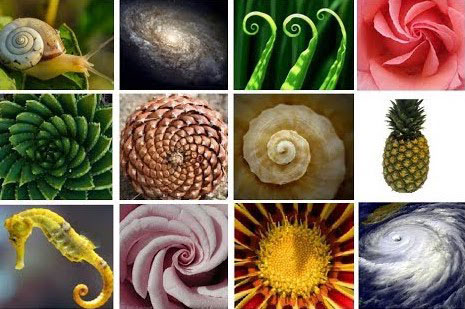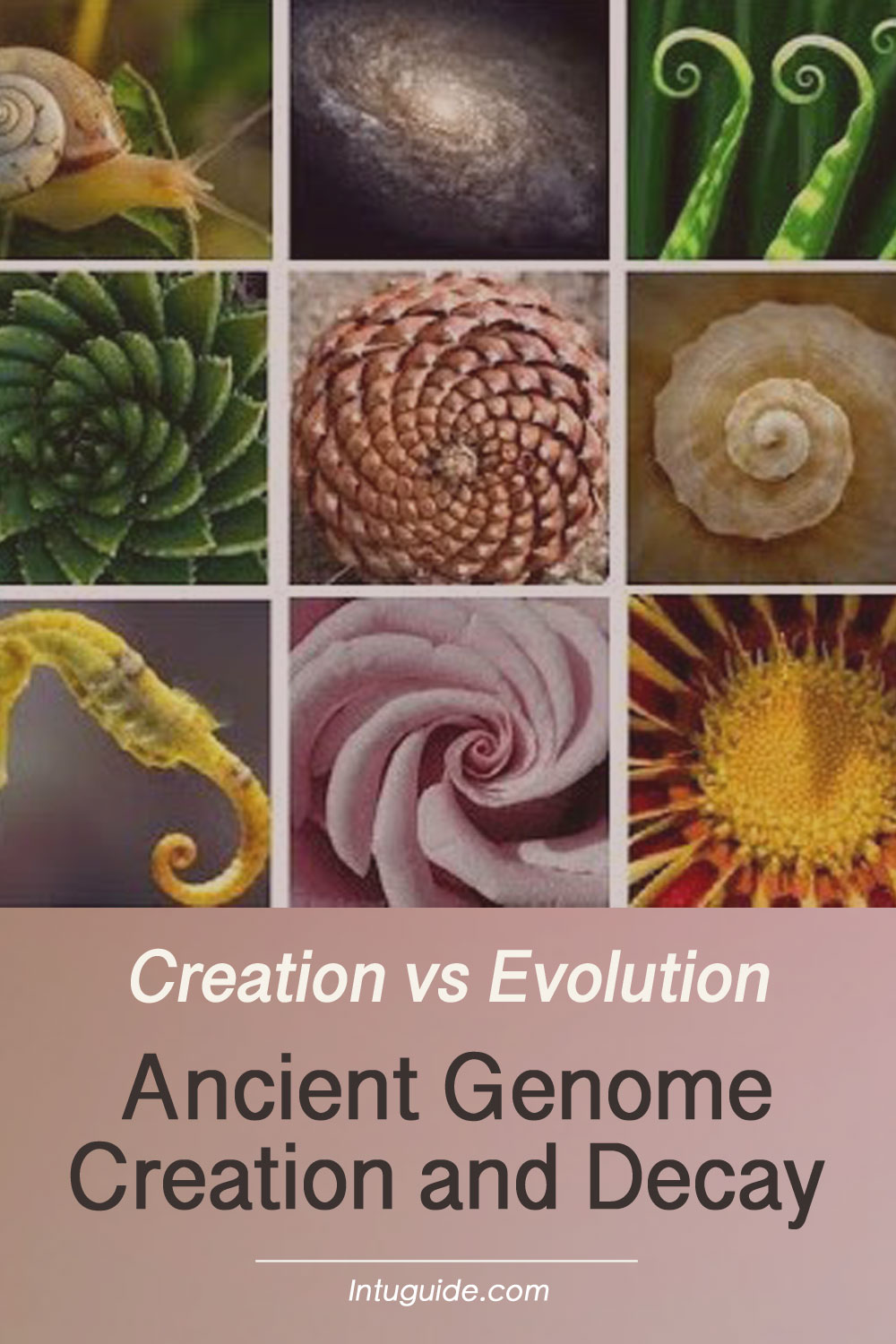The theory of evolution vs creation of the ancient genome assumed the development of species from simple to complex forms. According to this, humans should develop into more complex entities, be more healthy, stronger and live longer.
This is true for medical technologies and quality of life when comparing modern times with the Middle Ages, from the 5th to 15th centuries, but not when it comes to modern-day health issues. In today’s world, global atmospheric changes driven by natural and men made actions are causing health decline in present generations and are affecting the well-being of future generations.
The devastating effects of human actions are taking place around the world. A great example is air pollution in Beijing city, China. Residents had to wear masks due to the difficulty of breathing. The smog felt like a toxic gas and it was so bad that people could barely go outside.

Some of the atmospheric changes are natural due to the intensity of solar radiation, volcanic eruptions, solar wind, and cosmic rays affecting the energy balance, dynamics, and chemistry of the atmosphere. Natural causes are either periodic or episodic and normally pose a little threat to the equilibrium of the global Earth system.
Other atmospheric changes caused by human actions have a long-term effect that leads to permanent devastating effects such as the depletion of the Earth’s stratospheric ozone layer that shields everything from harmful solar radiation.
Ancient Genome Creation
As the complex cell needs all its basic parts with its various functions for survival, human beings, as complex organisms, came from fully evolved ancestors. The first humans were most likely well-developed Homo sapiens with healthy genes, DNA strand good for an inheritance, body system without genetic mutations, or environmental toxin pollution.
Our first ancestors were able to produce healthy and strong offspring with great survival skills. Many parts of the parental DNA have a single functional unit known as genes. Each unit of genes has different sequences of bases. This type of sequence is very advanced from the very beginning of its creation.
The genome of different animals produces a variety of different types of animals from jellyfish to lobsters and from butterflies to elephants. Many of these species share the same structural genes for organism development like collagen and enzymes.
Each group of animals has its own rules of development that are programmed within the small number of genes that shape the bodies of these animals. These genes construct the body plan of the organism and shape the future embryo within a human’s body. These genes are ancient, highly conserved, and shared by all species.
The species don’t look different in their structural genes such as those programmed in enzymes. The only difference happens in the regulation of gene expression by the resource genes. These genes are unchanged and reused many times in different parts of the embryo and at different stages of development, forming a complex system of management.
The ancient genes control and switch other regulatory and structural genes on and off in a precise pattern. These multiple pleiotropic reuses (the two or more unrelated actions by a single gene) explain why these genes are highly conserved. It explains why any change in structural genes would have many adverse consequences that are contrary to the theory of natural selection.
The highly conserved genes model could serve as evidence and fully support the theory of creation where humans, as complex species, were created as complete systems that don’t require a process of transformation from a single cell into a multi-cell organism.
This type of development can include some evolutionary changes such as genetic drift, genetic variations (genetic or environmental polymorphism), occasional mutations, and adaptation to the environment.
Unlike other theories that explain the sporadic development of species, the theory of creation describes the process where all living creatures serve a purpose in the ecosystem interdependence and follow some order for the efficient functioning of that ecosystem.
Any damage to the ecosystem will negatively impact everything in it eventually leading to chaos and destruction. Any unwise mind that creates a problem sooner or later risks facing that problem himself.
Evolution or Decay?
When little fossil evidence was found such as a single tooth, a bone fragment, or incomplete skull pieces, very often it results in unrealistic artistic presentation of humans as half man and half animal species residing in caves. With time, after discovering more skeletons and ancient archeology, researchers are concluding that ancient people were not as primitive as was assumed in the past. Even the most experienced evolutionists have to admit that Cro-Magnon and Neanderthals were fully human.
The fossils revealed that Neanderthals lived in caves of Western Europe, Eurasia, Central, Western, and Northern Asia, where stone tools and bone fragments have been found. They are thought to be extinct anywhere between 50,000 and 28,000 years ago for unknown reasons. The first skeletons were discovered in the Neander River in Germany, where “thal”/”tal” is a German word for “valley”.
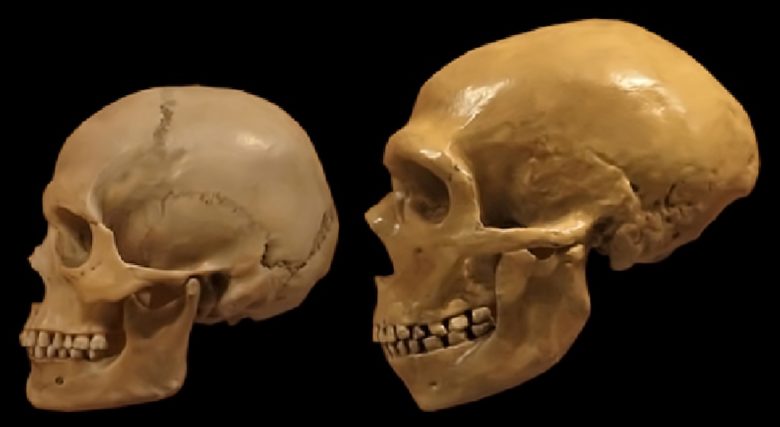
Neanderthal Human.
Hairymuseummatt (original photo), DrMikeBaxter (derivative work), Ephert (derivative work), CC BY-SA 2.0, via Wikimedia Commons
When they were first discovered in 1856, the researchers thought these bones belonged to a bear, as they were thicker than those of a human. The skeletons have been reconstructed and reveal the fact that the Neanderthals were shorter in height than modern-day humans yet had longer limbs, bigger skulls, and brains.
Evidence shows that Neanderthal anatomy has more robust built and distinctive morphological features. Based on 45 long bones from at most 14 males and 7 females, Neanderthal people were much stronger than modern humans and had red hair.
Just because Neanderthals were shorter than the average man and had sloping shoulders, they were not primitive and less intelligent than modern men. Shortness, prominent forehead, and sloping shoulders have nothing to do with intelligence, level of “advancement” or survival skills. This can be definite evidence that our ancestors were stronger, smarter, faster, and bigger.
Neanderthals may have better health and better eyesight. The brain space of the skull, and most likely the brain itself, was larger than in modern humans. Larger brow continued to grow the entire life of species.
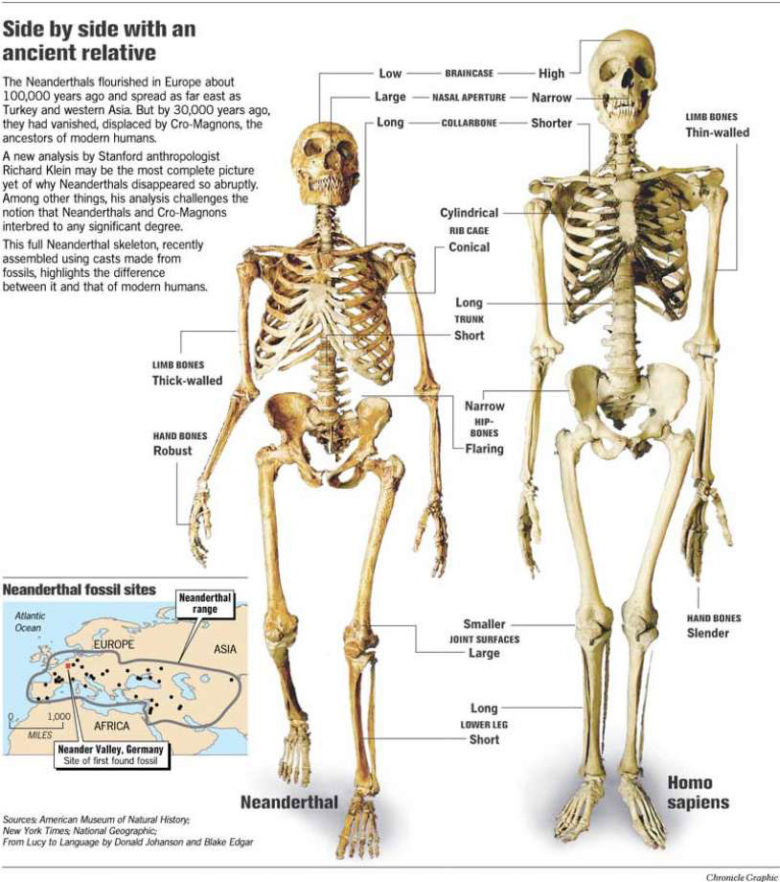
Graphic source: studypool
Similar to the Neanderthals, the evidence showed that Cro-Magnon people were highly artistic, used boats, had navigational and sailing skills practiced agriculture, and domesticated animals. They were also accomplished in mathematics, medicine, and astronomy. In other words, the Cro-Magnon people were civilized before ever occupying the shores of North Africa and Europe.
A recently discovered human gene, called FOXP2, is involved in the human ability to use speech and language. Chimpanzees, who are assumed to be humans’ closest animal relatives, don’t carry that gene, but Cro-Magnons may have. More research on human genes can bring more controversy to the theory of human-chimpanzee relations.
Epigenetic Decay
According to developmental biology, the mutation rate in a 100-base gene may be 10−7 per generation, epigenes may “mutate” several times per generation or may be fixed for many generations.
This leads to another conclusion: Rapidly decaying epigenetic effects on phenotypes (i.e. lasting less than three generations) may explain some of the residual variations in phenotypes after genotype and environment are accounted for.
These processes result in the next generation population of chromosomes that are different from the initial generation. Although crossover and mutation are known as the main genetic operators, it is possible to use other operators such as colonization-extinction, regrouping, or migration in genetic algorithms.
With each generation, DNA may weaken and deteriorate over time losing its material quality. As a result, modern generations are less healthy than ancient generations due to their genetic decay.
Climate Change and Advanced Development
As it was during the Early Cretaceous, Earth used to be warmer than it is now. Coal fossils and beds showed that lush fauna and forests grew in Antarctica and the northern region. Another indication of globally warm temperatures was found in the shells of marine organisms called Foraminiferans. Fossils dating from the Early Cretaceous showed the chemical signature of growth in ocean waters much warmer than today’s seas.
Similar to the Paleozoic and Mesozoic eras with ancient atmospheres, ancient humans may have lived in a sub-tropical climate with savanna plains and dense jungle (rainforest) regions. Neanderthals, for example, still carry evidence of body adaptation to the hotter climate.
Some assumed that Neanderthals had large noses for the cold adaptation, but arctic and primate animal studies have shown sinus size reduction in areas of extreme cold instead of enlargement which supports Allen’s rule. Thus, Neanderthal anatomy was not cold-adapted, but it was built to survive in a hot climate. The design of the extensive nose was an indication of the hotter climate of the Middle East that didn’t change in future generations.
The tribal-like environment was probably common among ancient humans who knew how to use simple and complex tools and advanced architecture. The ancient generations most likely had perfect genes without any known mutations that allowed them to maintain perfect health and to live up to 100 or 200 years longer than modern generations.
There is no definite answer to how long people lived millions of years ago, but it is a possibility that lifespan could be as far as 700 years for a person; similar to the age of patriarchs mentioned in Genesis:
Ages of the Patriarchs from Adam to Noah
| Patriarch | Age | Bible Reference | |
| 1 | Adam | 930 | Genesis 5:4 |
| 2 | Seth | 912 | Genesis 5:8 |
| 3 | Enosh | 905 | Genesis 5:11 |
| 4 | Cainan | 910 | Genesis 5:14 |
| 5 | Mahalalel | 895 | Genesis 5:17 |
| 6 | Jared | 962 | Genesis 5:20 |
| 7 | Enoch | 365 | Genesis 5:23 |
| 8 | Methuselah | 969 | Genesis 5:27 |
| 9 | Lamech | 777 | Genesis 5:31 |
| 10 | Noah | 950 | Genesis 9:29 |
| 11 | Shem | 600 | Genesis 11:10 – 11 |
| 12 | Arphaxad | 438 | Genesis 11:12-13 |
| 13 | Shelah | 433 | Genesis 11:14 – 15 |
| 14 | Eber | 464 | Genesis 11:16 – 17 |
| 15 | Peleg | 239 | Genesis 11:18 – 19 |
| 16 | Reu | 239 | Genesis 11:20 – 21 |
| 17 | Serug | 230 | Genesis 11:22 – 23 |
| 18 | Nahor | 148 | Genesis 11:24 – 25 |
| 19 | Terah | 205 | Genesis 11:32 |
| 20 | Abraham | 175 | Genesis 25:7 |
The ancient generations may have had certain body organs that became less prominent over time. For example, a parietal eye or a “third eye” could be a fully functioning body organ as it is often depicted in some ancient art. Human beings still have the prototype of the “third eye” known as the parietal eye or pineal eye.
The advanced “third eye” function gave ancient humans more developed extrasensory perception (ESP). Similar to wild animals, who have seismic sensitivity and use it to hide in a safe place before an earthquake or tsunami, ancient humans used ESP and received information with their minds without using the physical senses.
It was an important part of intuition that was necessary for survival, functioning, or decision-making. Unfortunately, the “third eye” functionality was evolutionarily degraded as it is an important part of the body for information processing.
In case of emergency, most people would rely on their logical thinking and ego-based thoughts, not the valuable information that comes through the six senses. Most of the time they are unable to distinguish fact from fiction and perceive false information as true.
The third eye was often depicted in old art and the statues of Buddha.
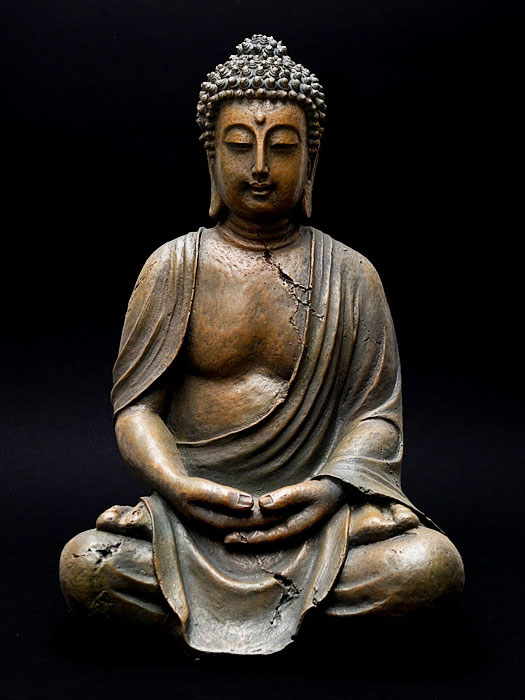
Statue of Buddha.
By Nomo/michael hoefner, CC BY 3.0 via Wikimedia Commons
With technological advancement, modern humans don’t rely much on their sixth sense for survival, and the extrasensory ability diminished over time. In the past, evolutionists would certainly call it an unnecessary body part that had to disappear over time due to inactivity, which is not true.
The pineal gland is very important for hormone regulation in mammals and vertebrates. For other animal species, the pineal gland is making one-half of the epithalamus, the subsequent structure is composed of the epiphysis (the pineal gland in humans, or pineal organ in other species), and the parietal organ (the “third eye”).
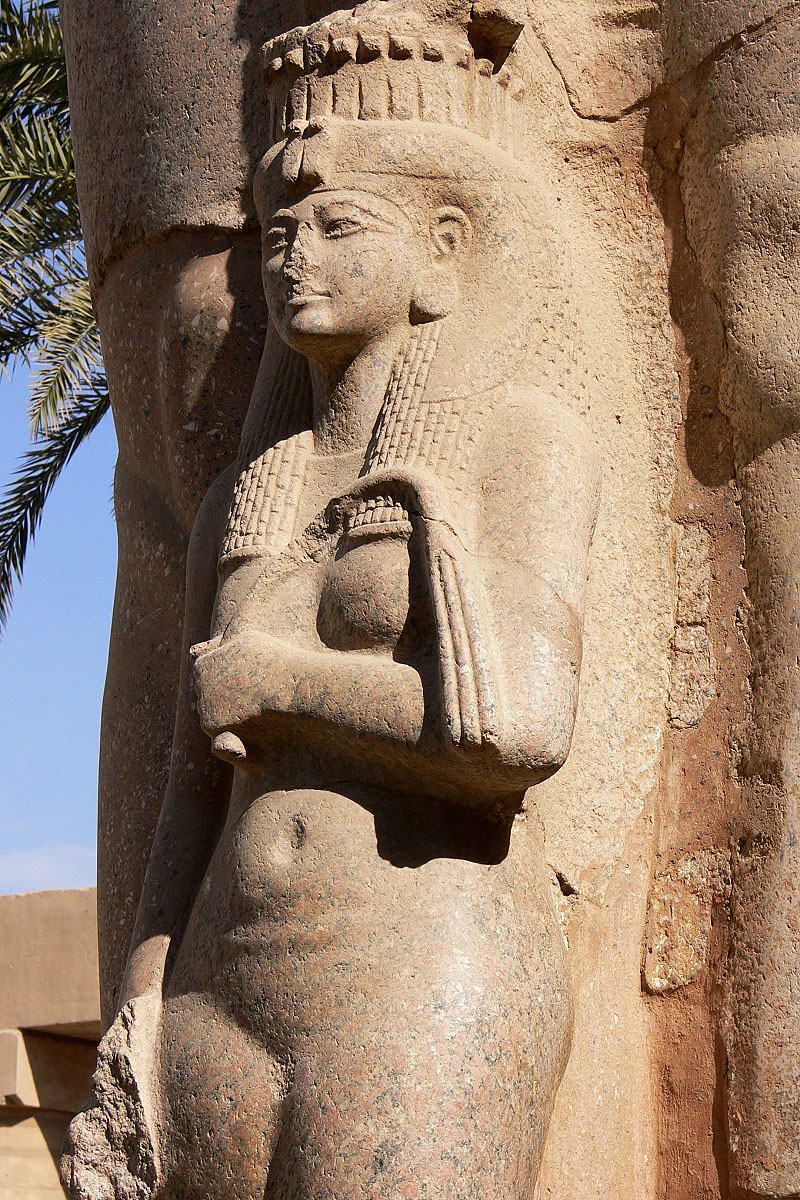
Nefertari
Image by Walwyn from VisualHunt.com
Even though the biblical Adam and Eve are often portrayed as fair-skinned with light hair in various art paintings, first humans most likely had a skin tone and type of hair specifically adapted for a hot climate. They likely had middle-brown skin color, dark curly hair, and a mixture of “light color” genes and “dark color” genes. As a result, their descendants have inherited a wide range of skin color and genetic variations in eye shape and other body features.
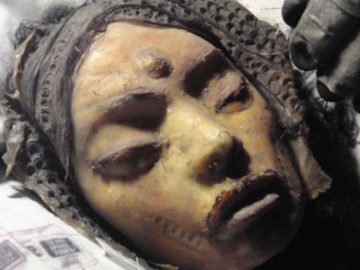
Apollo 20 “The Mona Lisa”.
by Fernando Valera Soundtracks from Youtube.com
Conclusion
Will future generations be more healthy and strong than previous generations? Will they live in a livable world tomorrow? The history of our planet shows evidence of global climate change, a cycle of the birth and separation of big continents, and the planet itself has experienced all types of natural disasters. However, modern-day cataclysmic events may bring devastating results. Our planet is currently experiencing natural and man-made environmental changes for economic gains, military, and various other purposes affecting nature and causing ancient genome decay and health decline in future generations.
*As an Amazon Associate, I earn from qualifying purchases.

